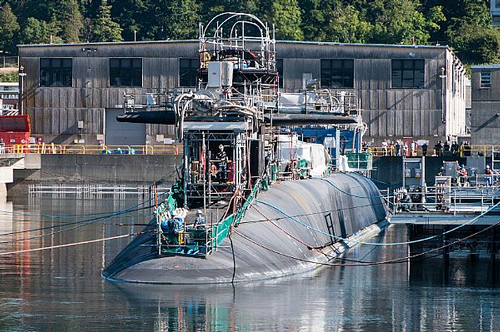Report: Shipyard Workers Exposed to Toxins
THURSDAY, NOVEMBER 9, 2017
A new investigative report from a Seattle-area television news program alleges that civilian workers at Puget Sound Naval Shipyard and Intermediate Maintenance Facility were exposed to toxins for years before the U.S. Navy took action on the problem.

 |
| Jelson25, CC BY-SA 2.0, via Wikimedia Commons |
|
Former employees say between 2006 and 2013, they were exposed to hazardous chemicals at a hazardous waste treatment facility at Puget Sound Naval Shipyard, in Bremerton, Washington. |
KING, Seattle’s NBC affiliate, reported Monday (Nov. 6) that the shipyard’s Building 1109, an industrial waste cleaning facility opened in 2006, is at the center of worker complaints, including allegations that employees who worked in the building have experienced health problems in the years since. The alleged exposures to chemicals including hexavalent chromium, lead, chlorine and cyanide, happened between the building’s opening and 2013, when new controls were put into place.
Exposure Concerns
The Navy told KING that a 2012 review based on employee concerns showed that there was no exposure to hazardous chemicals above Occupational Safety and Health Administration permissible exposure limits. A 2013 report obtained by the station indicates, though, that chemical mixing taking place at the facility may have exposed personnel to hazardous chemical vapors, and that training and communication issues exacerbated the issue.
A Navy representative told KING that with the 2013 improvements, which ran up a $2 million bill, the shipyard was “going beyond the legal requirement and minimizing exposure to the extent practicable.” The Navy denied that any workers suffered adverse health effects due to exposure in the building.
A separate 2013 report describes incidents in which chlorine levels in Building 1109 “exceeded established limits.” That report notes that the building included open tanks, though the original plans called for covers on tanks. A Navy spokesperson told KING that the omission of tank covers in the final design was not due to cost or time concerns, and said that the design was “state-of-the-art at the time.” The lids would only have served to protect the liquids in the tanks from debris falling from above, the Navy says.
 |
| U.S. Navy photo by Jason Kaye |
|
Puget Sound Naval Shipyard and Intermediate Maintenance Facility is one of the Navy's four shipyards. |
KING reports that a former supervisor at PSNS, Kevin Albert, has been diagnosed with vocal cord dysfunction, occupational reactive airway disease and other conditions that doctors said were caused by occupational exposure. Albert is considering legal action against the shipyard, according to the report. Other employees told the station they too experienced health problems stemming from exposure at Building 1109.
OSHA Violations
Citation records obtained by PaintSquare Daily News show that in 2013, OSHA issued two "serious" citations to the Puget Sound Naval Shipyard in relation to chemical exposures at Building 1109. According to the citations, during the cyanide destruction process, chlorine gas was emitted above the level of 10 parts per million, the National Institute for Occupational Safety and Health's "immediately dangerous to life or health" (IDLH) level.
The second citation said that the shipyard did not properly train workers on the dangers of chlorine gas in the cyanide destruction process. Both violations had to be abated by November 2013, but neither carried a monetary fine, as OSHA does not issue fines to federal government entities.
Plating Waste
Puget Sound Naval Shipyard, in Bremerton, Washington, is one of four Navy shipyards in the U.S. The 173-acre facility employs more than 13,000 civilians and was funded at $1.95 billion in 2016.
According to KING, the shipyard generates thousands of gallons of hazardous liquids daily. Processes that generate wasted at the shipyard include electroplating and coating. Navy documents indicate that in the past, the majority of the waste being treated at Building 1109 has come from the plating process.
Tagged categories: hazardous materials; Hazardous waste; Health & Safety; Health and safety; Hexavalent chromium; Lead; Shipyards; U.S. Navy








